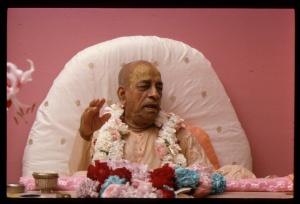CC Madhya 19.16 (1975)

A.C. Bhaktivedanta Swami Prabhupada
Below is the 1996 edition text, ready to be substituted with the 1975 one using the compile form.
TEXT 16
- lobhī kāyastha-gaṇa rāja-kārya kare
- āpane svagṛhe kare śāstrera vicāre
SYNONYMS
lobhī—greedy; kāyastha-gaṇa—persons engaged in secretarial and clerical work; rāja-kārya kare—executed the government service; āpane—personally; sva-gṛhe—at home; kare—did; śāstrera vicāre—discussion of the revealed scriptures.
TRANSLATION
The greedy masters of his clerical and secretarial staff performed the government duties while Sanātana personally remained home and discussed the revealed scriptures.
PURPORT
Sanātana Gosvāmī was the minister in charge of the government secretariat, and his assistants—the undersecretaries and clerks—all belonged to the kāyastha community. Formerly the kāyasthas belonged to the clerical and secretarial staff of the government, and later if one served in such a post, he was called a kāyastha. Eventually if a person could not identify himself as a brāhmaṇa, kṣatriya, vaiśya or śūdra, he used to introduce himself as a kāyastha to get a wealthy and honorable position. In Bengal it is said that if one cannot give the identity of his caste, he calls himself a kāyastha. On the whole, the kāyastha community is a mixture of all castes, and it especially includes those engaged in clerical or secretarial work. Materially such people are always busy occupying responsible government posts.
When Sanātana Gosvāmī was relaxing and feeling inclined to retire from government service, many kāyasthas on his secretarial staff were very eager to occupy his post. In this regard, Śrīla Bhaktivinoda Ṭhākura states that when Sanātana Gosvāmī was a government minister and the kāyasthas who assisted him saw that he was reluctant to continue, they became very expert in their duties. Sanātana Gosvāmī was a brāhmaṇa belonging to the Sārasvata brāhmaṇa community. It is said that when he resigned, a subordinate named Purandara Khān, who was a kāyastha, occupied his post.